“The best marketing doesn’t feel like marketing.” – Tom Fishburne
Imagine a scenario when you want to buy something that you need, maybe a product or a service, and you have just started your research online.
While you browse online, looking for a solution to your problem, you are stuck between a couple of choices. How do you decide? As a buyer, you are looking for more concrete evidence that this product or service works. This part becomes more critical when you are going to make a significant investment or long-term to mid-term choice of going with a service partner.
Now imagine that you get your hands on a case study, which explains to you exactly how the service has benefited another customer. Your interest is piqued, you feel more confident about making a choice now, and it definitely makes your more prone to buying from that brand.
So, what did the case study do?
It gave you evidence that the service was good, from another customer. This content piece handed over to the prospect information that influenced the buyer decision and helped the prospect make a choice, or atleast come close to a choice.
In the world of content marketing, the prospect just moved from the middle of the marketing funnel to the bottom of the marketing funnel. This means from a place of indecision, he is now closer to make a choice. That is how powerful a good case study can be. It can become a powerful instrument of sale, when written well.
Categorised as a “middle of the funnel” content format, case studies are about building trust, offering value, and telling compelling stories with evidence.
This helps the prospect move out of the messy middle stage of the buyer’s journey.
They are the ‘social proofs’ that tell your potential customers that your product or service has worked wonders before and can do it again.
What is a case study in simple language?
A case study involves closely examining a real-life situation where a business was offered a particular service and the documentation of how the process was implemented, the challenges that were faced, the goals that were met, and the results that were obtained. A case study is usually developed by the business that offers the service or product.
Writing a case study is a great way to let other companies shine a spotlight on your excellence. A well-crafted case study is akin to storytelling. It explains in detail the experiences of a client you’ve assisted, the hurdles they faced, and how your business played a crucial role in helping them overcome those challenges.
The ultimate goal of a case study is to convert a prospect into a buyer, by offering concrete evidence of the level and quality of a service, and the benefits reaped by a customer who has availed it before.
How Do You Start Writing a Case Study?
There are different approaches to follow while writing case studies for different disciplines. For example, a business case study has a broader focus on various aspects of a business, while a marketing case study specifically highlights and showcases your success stories as a business.
Wondering what case study methods to employ for your case study?
Here’s your roadmap on how to write a marketing case study for your business.
1. Craft a Captivating Story
“Marketing is no longer about the stuff you make, but the stories you tell.” – Seth Godin
Every great case study needs a compelling narrative. Start with a preview that hooks your readers. Give them a taste of the insights they’ll gain from your case study. Set the scene by providing a bit of background about the client. Make sure your readers know that this story is relevant to them.
For example – here is a small intro we created for a case study that we were creating. The small intro sets the tone for what to expect.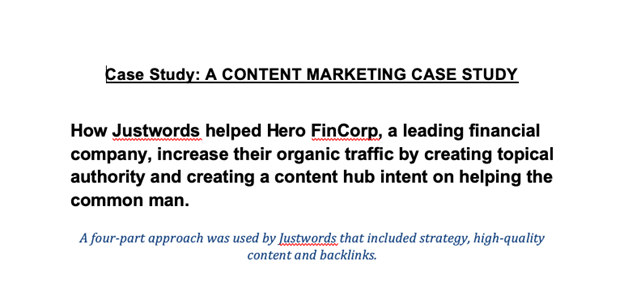
2. Lure them in with the Title
Your title should have three key elements: your client’s name (credibility booster), the product or service used (relevance indicator), and attention-grabbing stats, showcasing the results. Nothing better than numbers to attract the client.

Here is an example of how we used stats to showcase a case study in the banner.
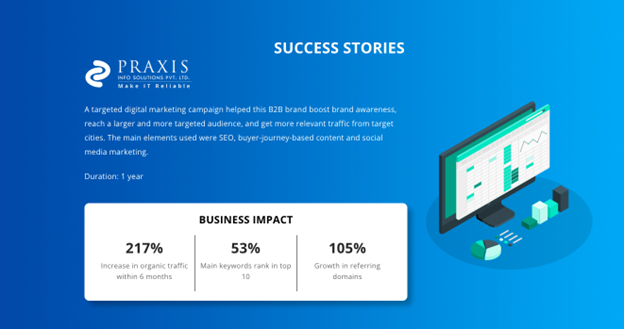
3. Research, interview, structure, restructure…then, some more research
For a case study content writer, the most important part is getting the facts right. You need to know everything about the plot of the story. What problem was the client facing? Why did they come to your brand? How did your brand help them out? And perhaps the most exciting part — what were the results achieved? Was the customer happy? Why?
Once you have all these pieces of information, you can start writing.
Following the right case study format lays down the foundation for a convincing story. Keep the structure as simple as you can. The reader should be able to scan through your case study. It shouldn’t be complicated and must focus on the most important things. Here’s a simple case study format:
- Title
- The client
- The challenge
- The solution
- The results
4. Put the Customer in the Spotlight
Remember, it’s not about how amazing you are; it’s about your customer’s success. Use direct quotes to let your customer’s voice shine through. Share why they chose you and how it transformed their business. Remember, your client is the hero of the case study. You are just the friendly sidekick who helped the hero get what he wanted (amazing results)!
5. Let Your Customer’s Voice Shine with Quotes
“Your brand is what other people say about you when you’re not in the room.” – Jeff Bezos
Quotes add credibility and personality. Your customers can sing your praises better than anyone. Highlight specific, resonant quotes that bring their experience to life.
I like how Omniscient has added the customer’s video right at the top.
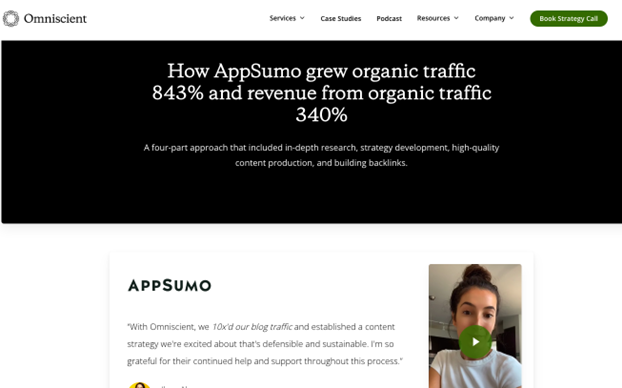
6. Use Hard Numbers
“Good content isn’t about good storytelling. It’s about telling a true story well.” – Ann Handley
At the beginning of the blog, we told you that 90% of consumers used the internet to find a local business in the last year, and 82% of consumers read online reviews. Now think about it: Just because we showed you numbers, you automatically thought that we had researched well before writing this. You suddenly trusted our content more and continued reading. That’s the power of numbers.
7. Guide Your Reader with a Call to Action
Your reader has stuck with you until the end of your case study. This means they are interested in what you are doing. They want to know if you can do the same or even something better for them. This is the time to give a great ending to the story. Guide them where you want them to go next with a Call to Action. End with a clear CTA that speaks directly to your target audience.
Here is a great CTA used by Active Campaign in one of their case studies.
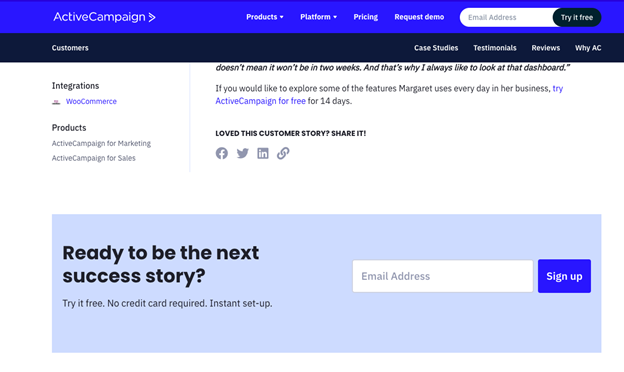
8. Learn from Others
Review your competitors’ case studies to gather inspiration. Critique what works and what doesn’t, like titles, imagery, testimonials, and stats.
9. Get More Mileage from Your Case Studies
Now that you know that writing case studies can be time-consuming, don’t let them go to waste. Don’t let your case studies gather dust. Repurpose your content.
- Feature Them on Your Website: Dedicate a section on your website to showcase your case studies. Highlight them on the homepage and relevant service pages.
- Incorporate into Email Signatures: Include links to recent case studies in your email signatures, especially for your sales team.
- Utilise Different Formats: Convert case studies into various formats, such as videos, infographics, newsletters and social media posts.
- Empower Your Sales Team: Provide case studies to your sales team for use in presentations and conference talks.
- Podcast Episodes: Discuss case study successes and lessons learned in podcast episodes.
- Customer Testimonials: Incorporate quotes and testimonials from case study subjects into marketing materials and product pages.
Tips to Write a Good Case Study
Finally, here are some valuable tips for writing a good case study that grabs attention and converts.
- Talk about things that your ideal customer can relate to. There’s nothing that keeps readers hooked like a relatable protagonist.
- Write the events of the case study chronologically, from beginning to end.
- Use persuasive words that encourage readers to take action.
- Organise your thoughts using bulleted points for clarity.
- Get to the point quickly and avoid unnecessary words or jargon.
- Highlight the measurable results your clients achieved by working with your product or service.
- Use a language that evokes emotions to connect with your audience on a personal level
- Enhance readability with headers, images, bulleted lists, and formatting like bold or italics.
- Incorporate quotes and testimonials from customers to add credibility and relatability
- Clearly showcase the “before and after” results to illustrate the impact of your solution
- Maintain a detailed yet approachable tone in your case study, avoiding overly complex language.
- Use specific numbers to provide proof of your product or service’s effectiveness.
- Explain in-depth how you achieved the results, such as content production or SEO improvements.
- Engage with the individuals who worked on the project and interview them to gather insights on the difficulties they faced, how they managed client expectations, and the strategies employed to overcome challenges. Incorporating firsthand accounts adds depth and authenticity to your case study.
Case Study Examples
1. Content-based case studies – Breadcrumbs
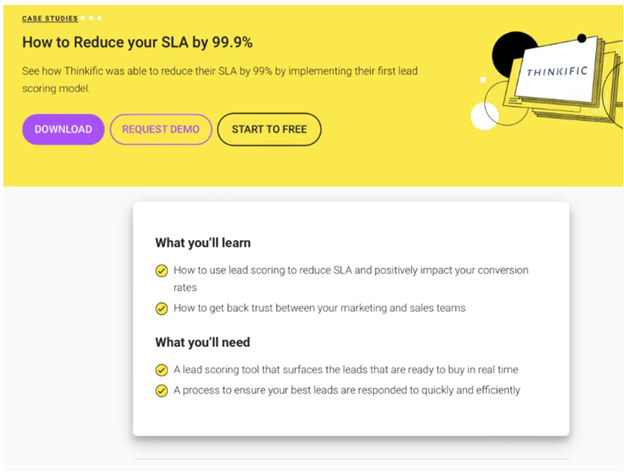
These case studies really nail all the stuff we talked about earlier. They lay out the client’s issues and pains, break down how they solved them, and even throw in the results and client shout-outs. They’ve got all the key elements in there. They make it easy for others to follow in their footsteps, with no mystery, no secrets, little to no numbers and just good old-fashioned know-how.
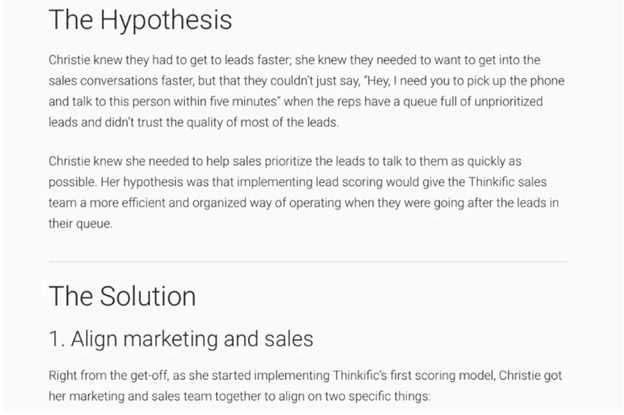
What worked here: Breadcrumbs’ case studies lay out challenges, solutions, and results with clarity with a no-nonsense, expert approach.
2. Case study tailored to specific audience – Freshbooks
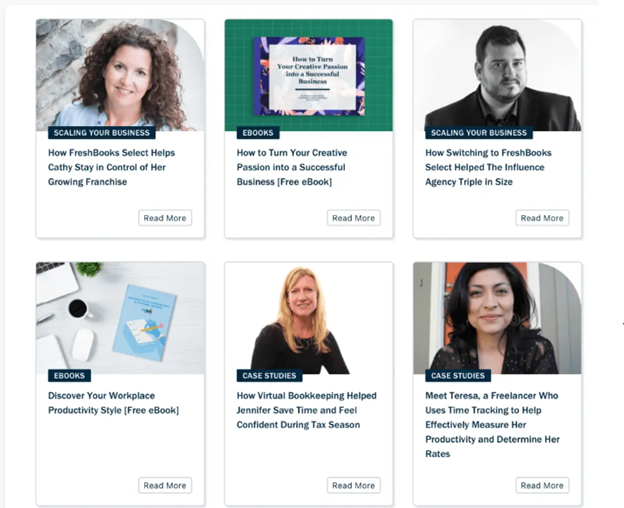
When it comes to creating effective case studies that resonate with various buyer personas and audience segments, Freshbooks sets a great example. Their approach to case studies ensures that they’re not just telling the same old story to anyone who’ll listen. Nope, they’re tailoring their content to fit the shoes of every audience member.
What’s impressive is the range of personas represented in these case studies. They cover the entire spectrum.
This ultimately boosts lead generation across the board. It’s a smart strategy that speaks directly to the varied needs of their customer base.
What worked here: Freshbooks hits the bullseye with case studies tailored to diverse personas, boosting lead generation by speaking directly to varied customer needs.
3. Case studies that tell a story – Slack
During the time of the pandemic, WFH became the norm and Slack became a household name for many. Now, when it comes to case studies, you’d expect Slack to ace the game, and they do. Their case studies read less like your typical dry research paper and more like gripping blog posts with strong storytelling. And as we know, storytelling is a mighty force, one that sticks with you long after the tale’s been told.
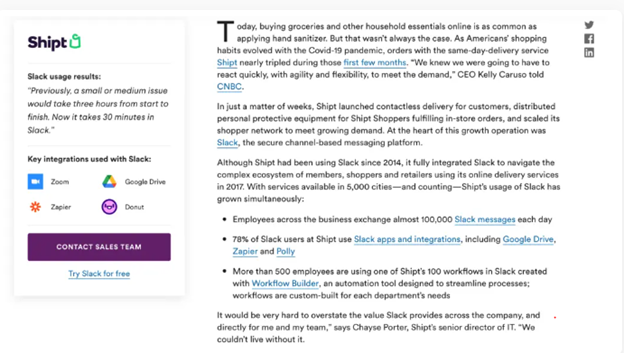
Take this case study, for example. It’s not just about charts and graphs (although they’ve got those too). But what really seals the deal is the voice of experience. The director of IT chimes in, underlining just how critical Slack became in those trying times. And that ‘quick facts’ tab on the side? It’s got a knockout quote that screams value. Key integrations get their moment in the spotlight, and there’s a call to action, not once but twice – one to connect with the sales dream team and the other to dive into Slack’s world for free.
What worked here: Most of Slack’s case studies are casual, relatable, and pack a punch. Because when you’ve got a good story to tell, the impact lingers, just like Slack’s lasting impression in the world of remote work.
4. Putting impact first in case studies – Asana
Asana knows how to make their case studies click. They kick things off by showcasing the impact they’ve made. They’re also savvy about delivering bite-sized client info right there on the page. When you take a look at the Asana case study, you’re not left guessing.
You’re hit with the ‘wow’ factor right from the get-go. They don’t bury the lead; they put their success stories at the front.
And a quick snapshot of the client’s background that gives you just enough context. It’s a brilliant way to keep things focused and reader-friendly.

What worked here: Asana’s case studies grab attention by showcasing immediate impact, delivering concise client context, and keeping things reader-friendly.
5. User-friendly PDF case studies – Bit.ly
Bit.ly goes the extra mile by offering a downloadable PDF option for their case studies. With a simple click, you can download the case study as a PDF, ready to be viewed offline or on your device at your leisure. The PDF is designed for easy reading and comprehension. They’ve cracked the code on presenting information in a way that’s both appealing and straightforward.
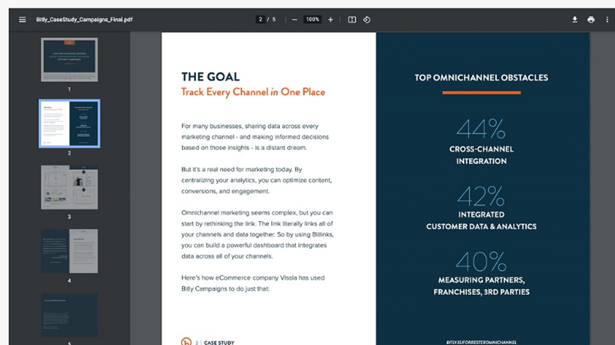
What worked here: Bit.ly simplifies case study access with user-friendly PDFs, offering a visually appealing and convenient way to digest information.
We hope this answers all your case study questions.
And remember, if you need a hand with your case studies, we’ve got your back. Happy writing!




